«Migration weapons»: the replacement of the Crimean population with Russian
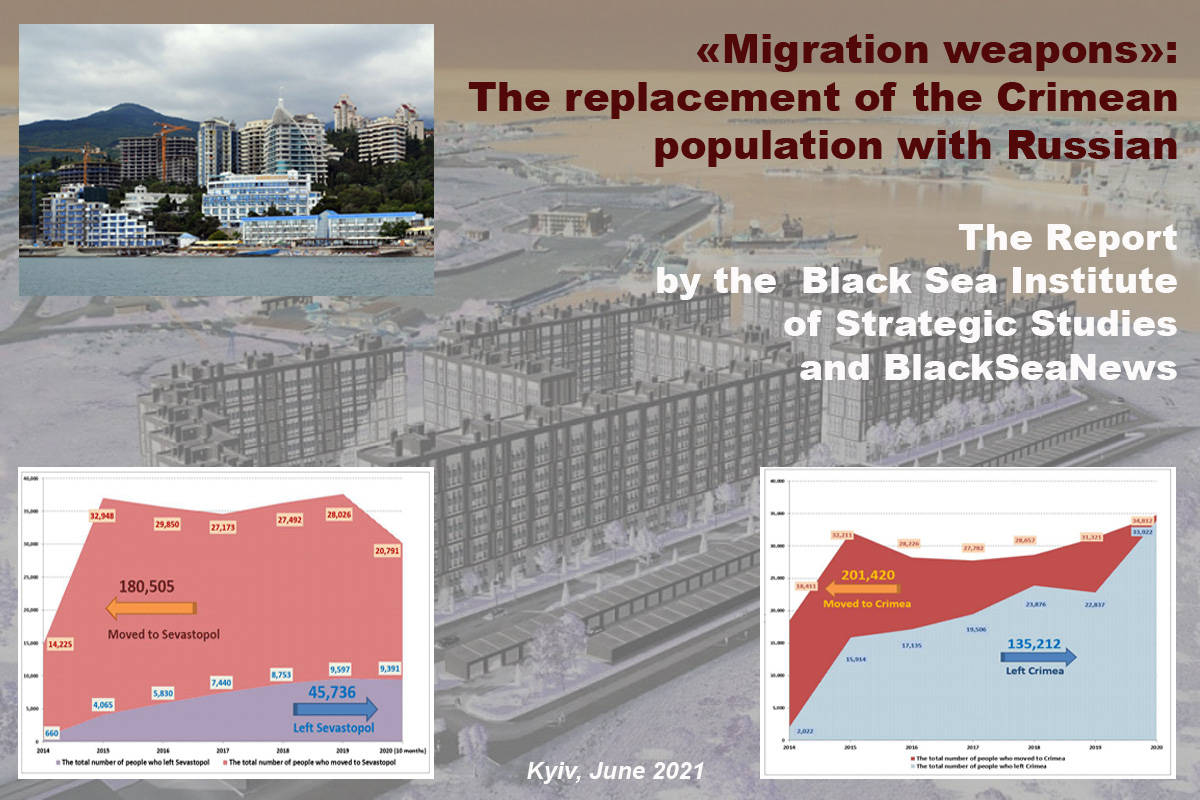
Andrii Klymenko
Head of the Monitoring Group of the Black Sea Institute of Strategic Studies on sanctions and freedom of navigation, Editor-in-Chief of the www.blackseanews.net online publication.
Tetyana Guchakova
Chairman of the Board of the Black Sea Institute of Strategic Studies, Editor of www.blackseanews.net, Expert of the Monitoring Group
The Monitoring Group of BlackSeaNews
and the Black Sea Institute of Strategic Studies
presents an updated series of articles
«The Socio-Economic Situation in Occupied Crimea in 2014 – 2021»:
Back in the USSR. The Reverse Restructuring of the Crimean Economy / 2014-2021
The "Trophy Economy". Militarization as a Factor of Industrial Growth / 2014-2021
The "Trophy Economy". The Development of the Stolen Ukrainian Black Sea Shelf / 2014-2021
The Crimean "Trophy Economy": The Sale of Ukrainian Property. An Updated Review for 2014 – 2021
The Occupied Crimean Tourism / 2014-2021
Occupied Crimea. Exports and Imports / 2014-2021
The Banking System of Crimea: What is Really Happening on the Occupied Peninsula (Updated)
Investment. What the "Crimean" Federal Target Programme Finances / 2014-2021
«Migration weapons»: the replacement of the Crimean population with Russian
Water in Occupied Crimea / 2014-2021
The Crimean Budget. Small Business. Salaries and Pensions / 2014-2021
Part 1.
The size of the resident population of the occupied
Autonomous Republic of Crimea and Sevastopol in 2014-2021
“Migration weapons” and the socio-cultural transformation of a population in the process of colonising new territories by the Russian Empire and the Soviet Union have a long history. Throughout this history, Russia has accumulated considerable experience and built a strong scientific and historical foundation.
Since Crimea fell into the sphere of Russia’s geopolitical interests in the 18th century, the demographic history of the peninsula has consisted of several periods following the same patterns: they always began with the socio-cultural destruction of Crimea and ended with its transformation according to the standards established by the occupiers.
At all historical stages, the Russian Empire and the USSR made extensive use of “migration weapons” in Crimea. Their goal was always to displace (by stimulating emigration or deportation) the indigenous Crimean Tatar population and populate Crimea with newcomers from Russian regions (or even foreign colonists with necessary competencies).
That is why after the occupation and attempt to annex the peninsula in 2014, non-recognised by the civilised world, we expected a new demographic policy of the Russian Federation towards Crimea. Note that in Russian history, the managed migration of the Russian population to newly occupied territories has always been part of the redevelopment of the “trophy” area for new purposes, aimed at a dramatic change of the territory’s functional specialisation.
During the occupation, the authors have been conducting monitoring of the official and other relevant information, bearing in mind that Russian statistics in general and the statistics of the occupation administration of Crimea and Sevastopol in particular are not a tool of analysis but largely a means of disinformation.
An array of information in various areas, which has been accumulated since February 2014, makes it possible to draw rather firm conclusions. Unfortunately, the specifics of the situation where the sources of information live under conditions of total control by Russian special services and the “iron curtain” do not allow for the traditional references for security reasons. Therefore, the reader will have to take some of the authors’ theses on faith.
It has already become well known that the main goal of the special operation to seize the Crimean Peninsula in February 2014 was to restore the function of the “unsinkable aircraft carrier of the empire” in the middle of the Black Sea.
Therefore, when studying migration, it was natural to divide the demographics of Sevastopol as the main military focus of Crimea and the rest of the Crimean Peninsula.
The size of the resident population
of the occupied Autonomous Republic of Crimea
in 2014-2021
According to the latest pre-war Ukrainian statistics, as of 1 January 2014, i.e. two months before the occupation, the resident population of the Autonomous Republic of Crimea (excluding Sevastopol) was 1,967,200 people.
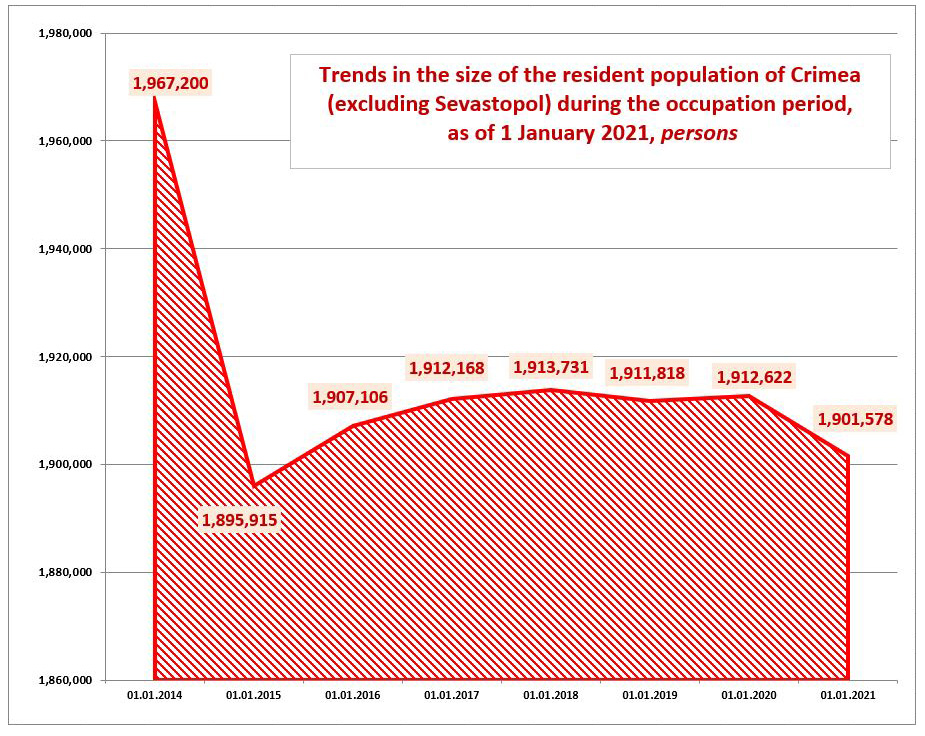
as of 1 January 2021, persons
One of the first measures the Russian Federation took after the occupation was conducting a census. It was taken on 14 October 2014. According to its results, the population of Crimea, excluding Sevastopol, was 1,891,465 people.
That is, the comparison of the official Ukrainian statistics and the census conducted by the occupiers shows a decrease in the population of occupied Crimea by 75,735 people over the nine months of 2014. This, in turn, gives an understanding of how many people left Crimea immediately after the occupation. The authors estimate that up to 80-90% of these people, i.e. 60-70 thousand persons, left for mainland Ukraine for fear of persecution.
This migration flow consisted mainly of active participants in the resistance to the occupation, journalists of independent media, civil activists of pro-Ukrainian organisations, including Crimean Tatar ones, and other people who could not imagine life under occupation due to their beliefs.
Official statistics of the occupying power (it is important to remember that these are Russia’s official statistics, which have long been a tool of propaganda and disinformation) show that during the occupation, the total size of the resident population of the peninsula, i.e. the number of people with officially registered permanent place of residence in Crimea (by the Migration Service of the Ministry of Internal Affairs of the RF), has not increased but remained virtually unchanged and even shows a downward trend (see Table 1, Figure 1).
Table 1. The size of the resident population of Crimea (excluding Sevastopol) in 2014-2021
|
Date |
Number of people |
Source |
|
01.01.2014 |
1,967,200 |
The State Statistics Service of Ukraine |
|
14.10.2014 |
1,891,465 |
Russian census |
|
01.01.2015 |
1,895,915 |
Rosstat |
|
01.01.2016 |
1,907,106 |
Rosstat |
|
01.01.2017 |
1,912,168 |
Rosstat |
|
01.01.2018 |
1,913,731 |
Rosstat |
|
01.01.2019 |
1,911,818 |
Rosstat |
|
01.01.2020 |
1,912,622 |
Rosstat |
|
01.01.2021 |
1,901,578 |
Rosstat |
|
|
|
|
Overall, according to official data, during the occupation, the absolute size of the resident population of Crimea has decreased from 1,967,200 (01.01.2014) to 1,901,578 (01.01.2021) people, i.e. by 65,622 persons, or 3.45%.
Note also that as of 01.01.2021, the official size of the resident population of Crimea was already slightly lower than the low end of Rosstat’s forecast for the peninsula’s population size in 2021-2036, which was issued in March 2020. According to that forecast, the resident population of Crimea at the beginning of 2021 was projected at 1,908,775 people.
Interestingly, according to the forecast, over the next 15 years, the resident population of Crimea is expected to decrease by another 145,873 people and amount to 1,762,902 people in 2036 (204,298 persons fewer than before the occupation).
The size of the resident population
of the occupied Sevastopol
in 2014-2021
During the years of the occupation, the size of the resident population of Sevastopol has shown fundamentally different trends from that of occupied Crimea.
According to the latest pre-war Ukrainian statistics, as of 1 January 2014, i.e. two months before the occupation, the resident population of Sevastopol was 383,304 people. The Russian census conducted eight months after the beginning of the occupation showed an increase in population by 10 thousand people. Then an unprecedentedly rapid growth due to migration began, which continues to the present day (see Table 2, Figure 2).
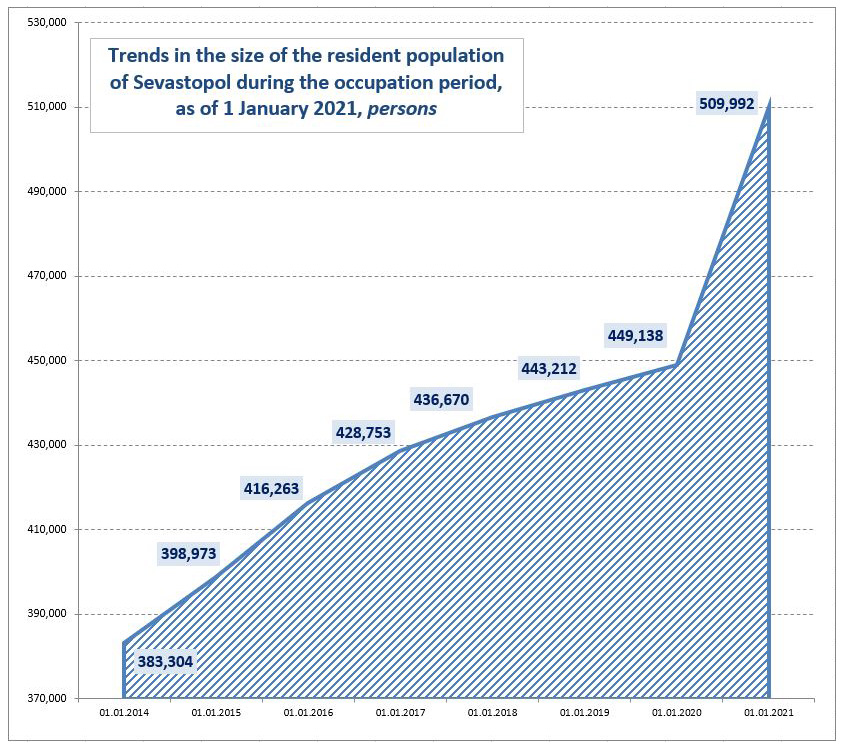
as of 1 January 2021, persons
Overall, according to official data, during the occupation, the absolute size of the resident population of Sevastopol has increased from 383,304 to 509,992 people, i.e. by 126,688 people, or by an unprecedented 33.05%.
Table 2 . The size of the resident population of Sevastopol in 2014-2021
|
Date |
Number of people |
Source |
|
01.01.2014 |
383,304 |
Ukrstat |
|
14.10.2014 |
393,304 |
Russian census |
|
01.01.2015 |
398,973 |
Rosstat |
|
01.01.2016 |
416,263 |
Rosstat |
|
01.01.2017 |
428,753 |
Rosstat |
|
01.01.2018 |
436,670 |
Rosstat |
|
01.01.2019 |
443,212 |
Rosstat |
|
01.01.2020 |
449,138 |
Rosstat |
|
01.01.2021 |
509,992 |
Rosstat |
|
|
|
|
This occupied Ukrainian city, according to Russian statistics, shows the highest population growth compared to the regions of the Russian Federation (in 2018-2020, the population of Sevastopol grew by 16.8%, of Ingushetia – by 5.6%, the Leningrad region – by 4.3%, and Chechnya – by 4.2%).
Note that according to the statistics (emphasis on the “statistics”), in 2020, the size of the resident population increased by 60,854 people, which is almost equal to the growth over the previous 6 years of the occupation, which amounted to 65,834 people. The reasons for this jump were explained by the official statistics bodies of the occupying power as follows.
The Directorate of the Ministry of Internal Affairs of the Russian Federation for Sevastopol has taken an inventory of primary source documents serving as the basis for the registration of the Russian Federation citizens on the territory of Sevastopol in 2015-2019. In the course of these activities, it was revealed that for 55,057 citizens of the Russian Federation, no statistical registration documents were drawn up. Since the Directorate of the Ministry of Internal Affairs of the RF for Sevastopol transferred the completed forms of federal statistical observation to Krymstat in 2020, the information obtained was taken into account in the preliminary estimate of the resident population of the Russian Federation as of 1 January 2021.
In the conditions of the Russian police state, especially in the conditions of occupied Crimea, such an explanation does not appear credible.
Most likely, the occupying power decided to hide a significant part of the information about the arrival of members of the Russian Armed Forces and their families in occupied Sevastopol for permanent residence. That could not last forever, as the size of the resident population is the basis for calculating the important parameters of budget funding for the needs of teachers, doctors, schools, kindergartens, and so on.
Note also that as of 01.01.2021, according to the available data, the size of the resident population of Sevastopol significantly exceeded even the high end of Rosstat’s forecast for the city’s population size in 2021-2036, which was issued in June 2020. According to that forecast, the resident population of Sevastopol is supposed to exceed 500,000 only in 7 years – in 2028 (2021 – 456,560; 2022 – 464,119; 2023 – 471,616; 2024 – 478,797; 2025 – 485,746; 2026 – 492,503; 2027 – 499,124; 2028 – 505,682; 2029 – 512,204; 2030 – 518,712).
Part 2.
Estimated external migration to Sevastopol
during the occupation period of 2014-2020
The difference between the trends in the size of the resident population of Crimea and Sevastopol during the years of the occupation prompts us to start the analysis with the city of Sevastopol. Namely, with external migration indicators for the region.
Note that in this study, the term “external migration to the region” means migration from outside the Crimean Peninsula (because migration between Sevastopol and the rest of Crimea is traditionally insignificant).
Table 3. Estimated external migration to Sevastopol during the occupation period of 2014-2020, persons
|
Year |
Total number of |
Number of migrants from Russia (est.) |
Number of migrants from “the CIS states” |
|
2014 |
14,225 |
11,380 |
2,802 |
|
2015 |
32,948 |
24,972 |
7,877 |
|
2016 |
29,850 |
24,417 |
5,342 |
|
2017 |
27,173 |
23,439 |
3,652 |
|
2018 |
27,492 |
23,827 |
3,586 |
|
2019 |
28,026 |
23,036 |
4,822 |
|
2020 |
20,791 |
14,848 |
5,853 |
|
Total |
180,505 |
145,919 (80.83%) |
33,934 (18.8%) |
Reference. Until 5 April 2016, the Federal Migration Service (FMS) of Russia, a federal executive body, was responsible for permanent residence registration and migration issues. On 5 April 2016, this agency was dissolved by a decree of the President of the RF, and its functions and powers were returned to the Main Directorate for Migration of the Ministry of Internal Affairs of the Russian Federation.
Thus, during the years of the occupation of the Crimean Peninsula, as of 1 January 2021, 180,505 people had moved to Sevastopol through the territory of Russia:
- 80.83% of them, or 145,919 people, had previously resided permanently in the regions of the Russian Federation;
- 18.8% of them, or 33,934 people, had lived permanently in the Donetsk and Luhansk regions of Ukraine.
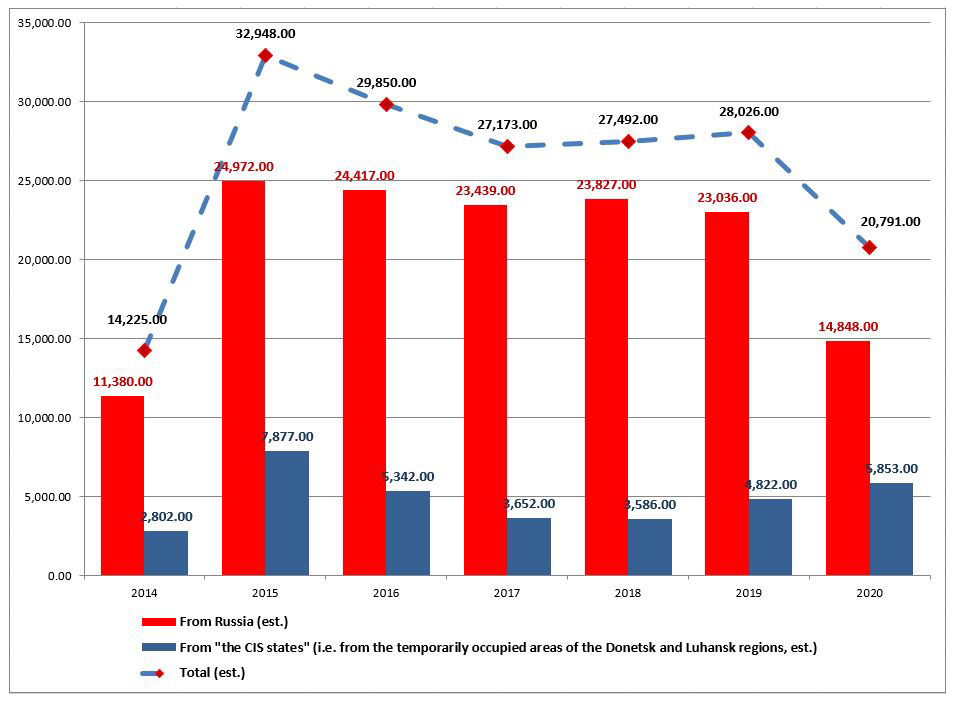
as of 1 January 2021, persons
In order to adequately assess the scale of the phenomenon, note that the number of external migrants has already amounted to 47.1% of the size of the resident population of Sevastopol before the occupation. That is, the migration gain has compensated for all the negative demographic processes in the city and provided an enormous increase in the size of the resident population.
It is worth mentioning that the migration gain as a result of the migration from the regions of the Russian Federation to Sevastopol has been constant and steady. This is the direct evidence of the systematic increase in the Russian military contingent at the main base of the Russian Black Sea Fleet: the migration flow to Sevastopol primarily consists of the Russian military and their families.
The prime motive for their official permanent residence registration in Sevastopol is the opportunity to take out preferential military mortgages to buy their own dwellings.
Another component of the migration flow that has been increasing the size of the resident population of Sevastopol is Russian retired people from remote areas of northern Russia and Siberia.
As to migrants from the Donbas, who are shown in Russian official statistics as “migrants from the CIS countries,” the real situation is different. The bulk of the migrants from the Donetsk and Luhansk regions moved to the Crimean Peninsula immediately after the beginning of hostilities in the Donbas caused by Russian aggression.
As early as the end of November 2014, the FMS of the Russian Federation spread the message that there were approximately 200,000 people in Crimea who had left the Donbas as a result of hostilities.
Note that before the occupation, there were a lot of recreational housing construction projects in Crimea. Those second homes by the sea were in great demand among people in eastern Ukraine. Therefore, many residents of the Donbas escaped the war by moving to their Crimean flats.
In addition, since the early days of the war in the Donbas, there has been close cooperation between the occupying authorities of Crimea and the puppet regimes of the so-called “people’s republics” in the Donbas.
This was manifested both in the training of militant units in Crimea and the treatment of the wounded, which have also become a factor in the “Donetsk migration” to occupied Crimea.
Therefore, Figure 3 on Sevastopol and Figure 4 on the Autonomous Republic of Crimea show not the annual trends in migration from the Donbas to Crimea, which has long been absent, but the trends in the process of obtaining Russian passports and permanent residence registration in Sevastopol and Crimea by the Donbas residents who arrived in the peninsula in 2014.
Characteristics and the ratio of the number of people who moved to Sevastopol
to the number of people who left the city in 2014-2020
Two parallel processes are taking place in Sevastopol: 1) population growth due to external migration, 2) population replacement by migrants, i.e. the compensation for the natural population decline and the replacement of those leaving Sevastopol and moving outside the Crimean Peninsula.
Note that the natural decline in the population of Sevastopol (i.e. the number of deaths exceeds the number of births) has been increasing year after year: 2015 – 593 people; 2016 – 530; 2017 – 816; 2018 – 1,197; 2019 – 1,503; 2020 – 2,132 people..
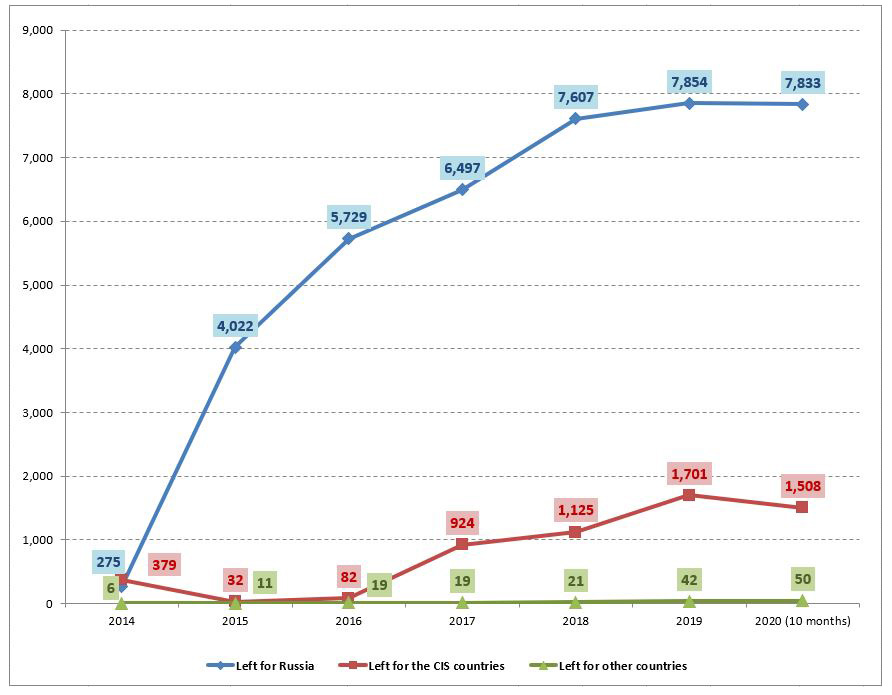
as of 1 January 2021, persons
The analysis of the data presented in Figure 5-S shows that during all the years of the occupation, residents of Sevastopol have been leaving the city to live permanently outside its borders. The number of such people is constantly growing. Sevastopolians moving to the Russian Federation form the basis of this migration flow.
In 2014 – 2019, this flow was increasing steadily and significantly: from 275 (2014) to 7,854 people (2019), and then it levelled off at about 8,000 people a year.
This migration flow mainly consists of young people leaving the city to go to higher educational institutions. The reason for that is international sanctions for the occupation and attempted illegal annexation of Crimea. One of the effective components of the sanctions regime is the non-recognition of any documents issued by the Russian Federation on the occupied peninsula, including diplomas of education. Those are recognised only in Russia, but even there, companies involved in international projects have long avoided hiring professionals with Crimean diplomas.
Since 2017, the flow of Sevastopolians leaving for mainland Ukraine has resumed (this figure is disguised in the occupiers’ statistics as “leaving for the CIS countries”). The size of this migration flow is about 1,000-1,500 people a year.
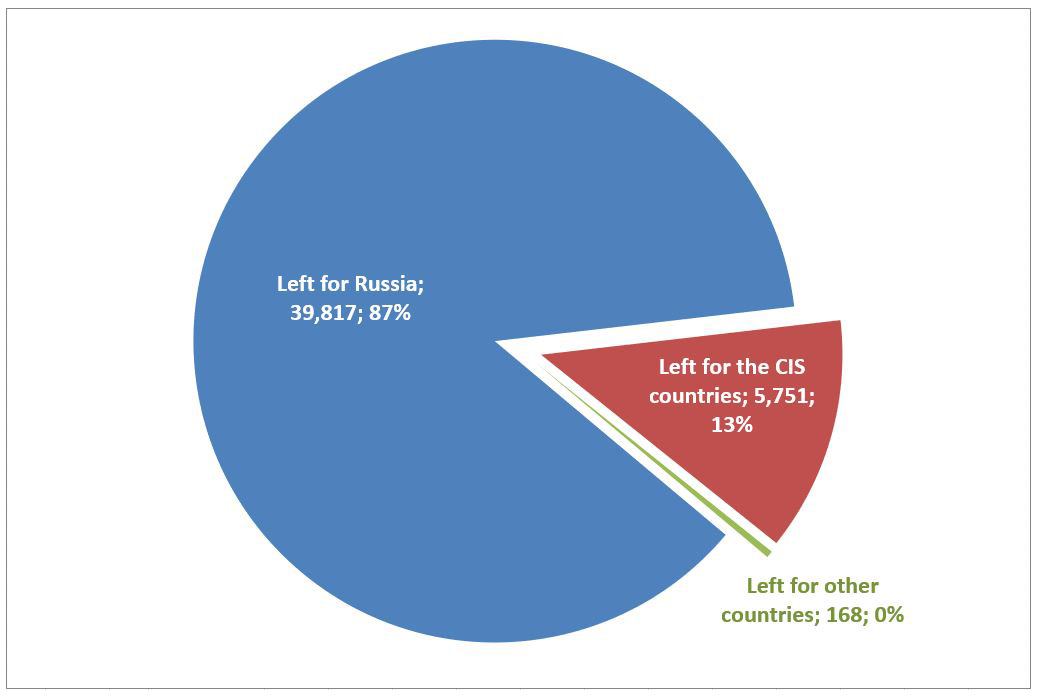
as of 1 January 2021, persons
The comparison of migration flows to and from Sevastopol during the occupation period of 2014-2020 (see Figure 7) clearly illustrates how the replacement of the population has been carried out.
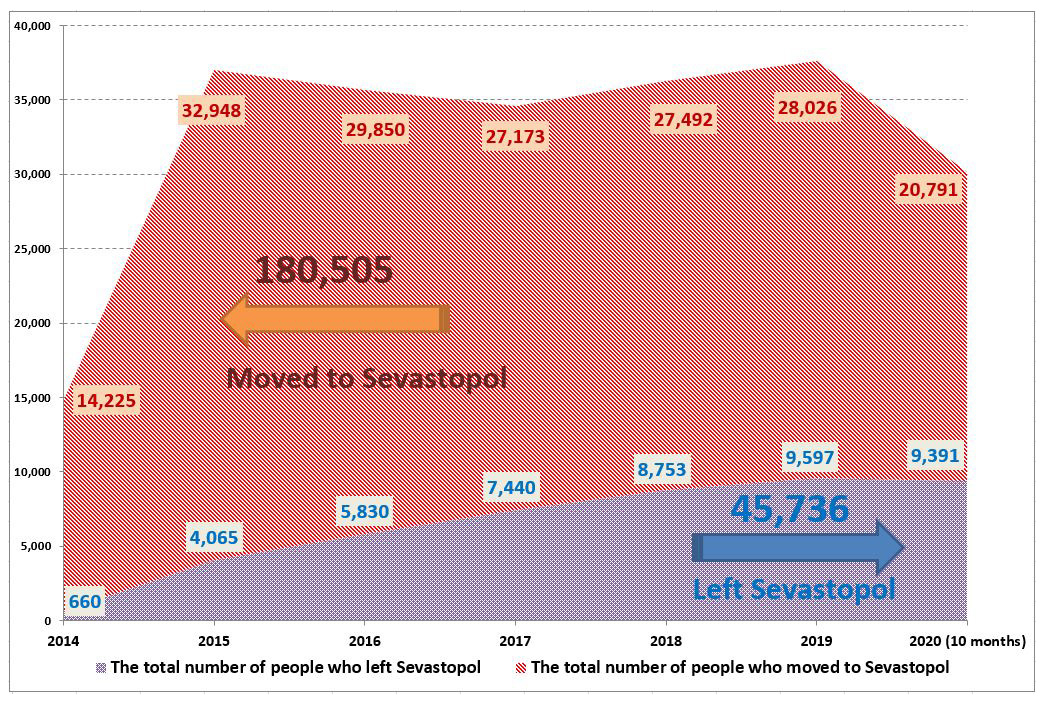
as of 1 January 2021, persons
Instead of 45,736 Sevastopolians who left the city in 2014-2020, 180,505 new “colonisers” moved to Sevastopol, i.e. there were 4 times more people who moved to the city than those who left it.
Part 3.
The resident population of occupied Crimea
(excluding Sevastopol) and external migration in 2014-2020*
According to the official statistics of the occupying authorities as of 1 January 2021, during the years of the occupation, 193,425 people (not including migration from foreign countries other than “the CIS states”) had moved to Crimea, excluding Sevastopol, through the territory of Russia:
- 61.4% of them, or 118,733 people, had previously resided permanently in the Russian Federation;
- 38.6% of them, or 74,692 people, had lived permanently in the Donetsk and Luhansk regions of Ukraine
* These calculations do not take into account external migration to Crimea from countries other than mainland Ukraine (the occupied part of eastern Ukraine), as this migration flow is of a different nature and relatively small: 2014 – 302 persons; 2015 – 693 persons; 2016 – 1,922 persons; 2017 – 1,430 persons; 2018 – 1,365 persons; 2019 – 1,490 persons; 2020 – 793 persons
In order to assess the scale of the phenomenon, note that over 2014-2020, the number of external migrants amounted to 9.8% of the size of the resident population of Crimea before the occupation.
Table 4. Trends in the number of people who moved to Crimea, excluding Sevastopol, during the occupation period, as of 1 January 2021, persons (not including migration from foreign countries other than “the CIS states”)
|
Year |
Total number of people |
From Russia |
From “the CIS states” |
|
2014* |
18,109 |
8,943 |
9,166 |
|
2015 |
31,518 |
14,644 |
16,874 |
|
2016 |
26,304 |
16,386 |
9,918 |
|
2017 |
26,352 |
17,061 |
9,291 |
|
2018 |
27,292 |
19,147 |
8,145 |
|
2019 |
29,831 |
20,157 |
9,674 |
|
2020 |
34,019 |
22,395 |
11,624 |
|
Total |
193,425 |
118,733 |
74,692 |
* In April and May 2014, registration/deregistration of residence in the Republic of Crimea was not carried out by the Migration Service. The registration of citizens in a new place of residence began in the last decade of June 2014. From July to December 2014, the number of migrants who left Crimea was recorded excluding those who left for Russia
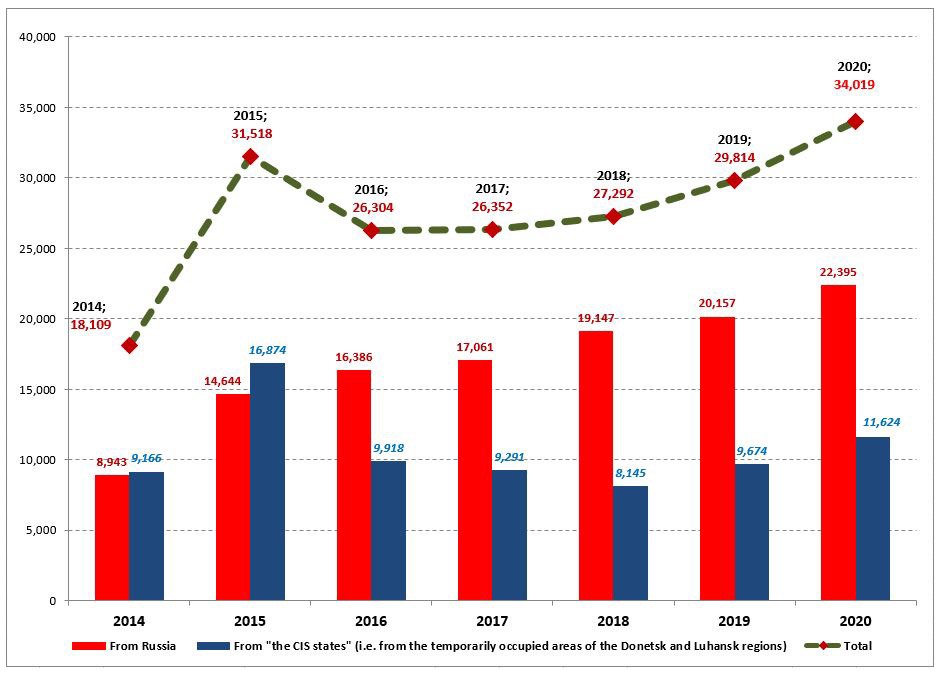
as of 1 January 2021, persons
That is, in contrast to Sevastopol, where that figure reached 33.05%, the migration gain in occupied Crimea has not even compensated for the natural population decline and has not increased the size of the resident population.
It is worth noting that the migration gain of the resident population (let’s emphasize the word “resident”) from the regions of the Russian Federation to occupied Crimea has been growing steadily during the years of the occupation.
However, the nature of this growth is more complex than in Sevastopol:
-
firstly, similarly to Sevastopol, it is the flow of migrants from the Russian military and members of their families, who have settled mainly in Yevpatoriia, Feodosiia, and Kerch;
-
secondly, similarly to Sevastopol, these are also Russian retired people from remote areas of northern Russia and Siberia, who buy apartments mainly in Simferopol or Yalta and other coastal cities;
-
thirdly, these are representatives of the Russian middle class, who change their permanent place of residence mainly for reasons of environmental and climatic conditions;
-
fourthly, it is part of Russian officials, mostly security officials, and members of their families, for whom having Schengen visas is not essential (which is not possible with permanent residence registration in occupied Crimea).
Characteristics and the ratio of the number of people who moved to Crimea
to the number of people who left Crimea in 2015-2020
We would like to draw attention to another important aspect of the problem: while in Sevastopol we mainly observe just an increase in the size of the population due to external migration, in Crimea, the replacement of the population is taking place, i.e. the replacement of those who leave the peninsula by those who move to Crimea.
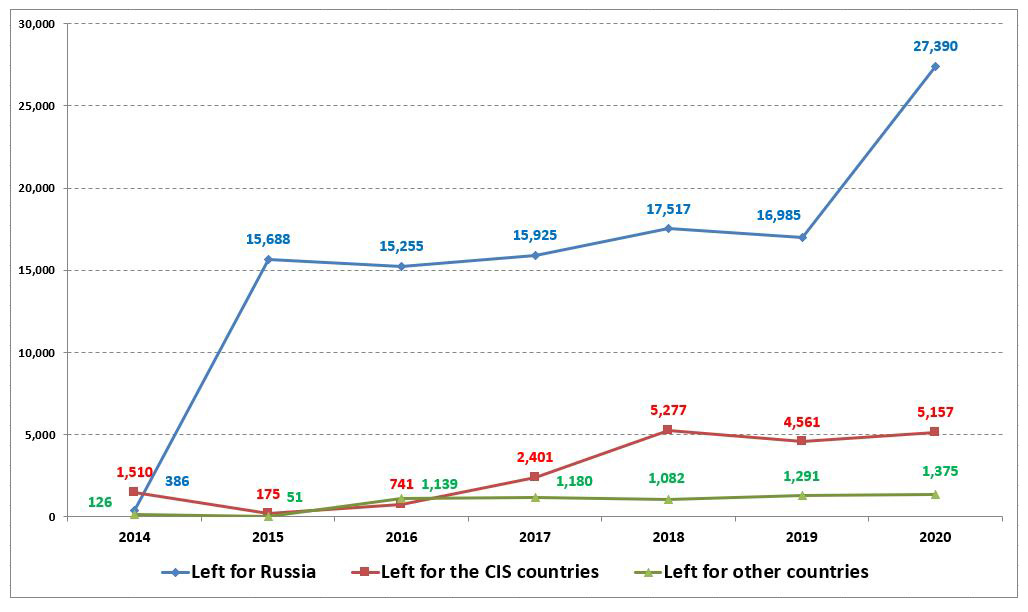
as of 1 January 2021, persons
From the analysis of the data presented in Figure 5, it is clear that during all the years of the occupation, there has been a very significant number of people leaving Crimea, which is comparable to the number of those moving to the peninsula. The basis of this flow is Crimeans moving to the Russian Federation.
In 2015-2019, this flow was relatively steady, ranging from 15,000 to 17,000 people a year. However, in 2020, the occupation statistics bodies recorded a sharp increase in the number of Crimean residents moving to the Russian Federation: 27,390 people.
This migration flow is mainly composed of young people who leave Crimea to go to higher educational institutions. The reason for that is international sanctions for the occupation and attempted illegal annexation of Crimea. One of the effective components of the sanctions regime is the non-recognition of any documents issued by the Russian Federation on the occupied peninsula, including diplomas of education. Those are recognised only in Russia, but even there, companies involved in international projects have long avoided hiring professionals with Crimean diplomas.
Since 2017, the flow of Crimean residents leaving for mainland Ukraine has resumed (this figure is disguised in the occupiers’ statistics as “leaving for the CIS countries”). The size of this migration flow is about 5,000 people a year.
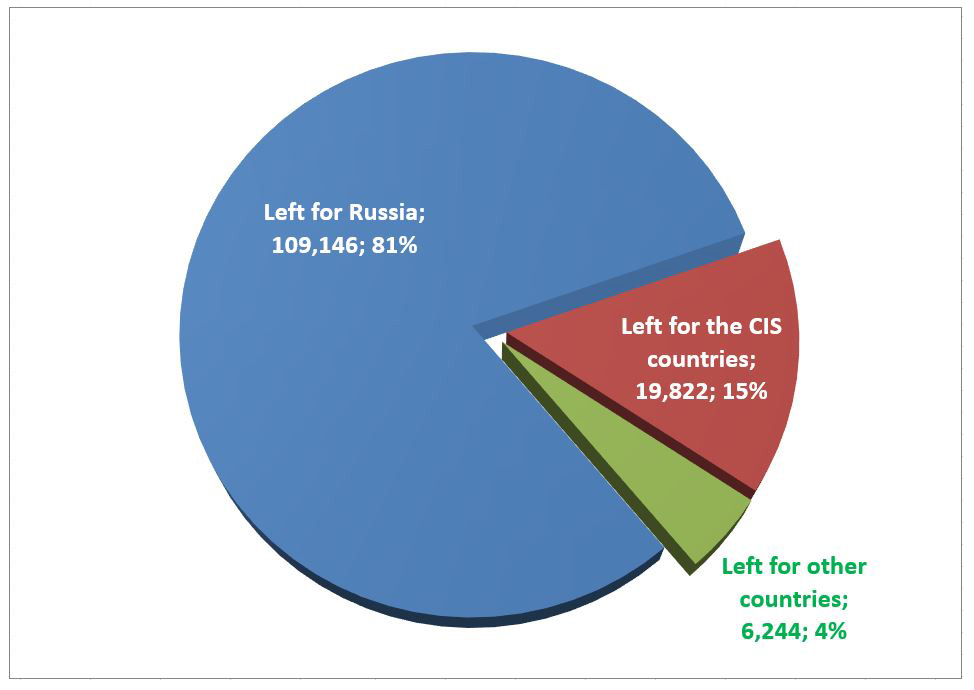
as of 1 January 2021, persons
In 2014, the first year of the occupation, reliable migration statistics on the number of people leaving Crimea were not produced. The comparison of migration flows to and from Crimea (excluding Sevastopol) during the period of the occupation from 2015 to 2020 (see Figure 7) clearly illustrates how the replacement of the population has been carried out.
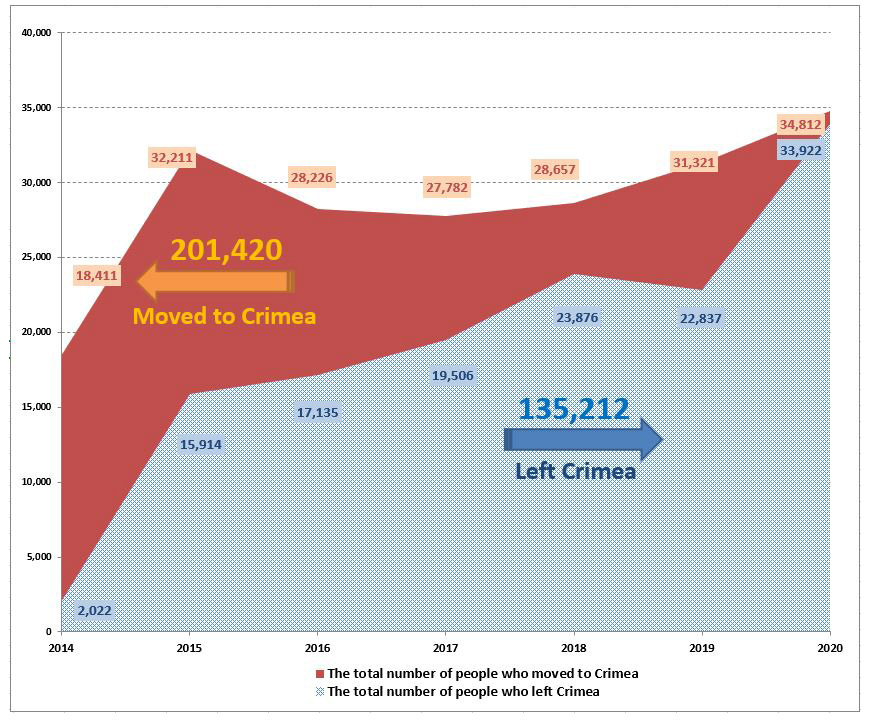
as of 1 January 2021, persons
Instead of 135,212 Crimeans who left the peninsula in 2014-2020, 201,420 new “colonisers” moved to Crimea, i.e. there were 1.5 times more people who moved to Crimea than those who left it.
In addition, about 70,000 Crimean residents who left the peninsula for political reasons in the first year of the occupation and became “internally displaced persons” should be added to this migration balance.
To draw conclusions and generalise, it is necessary to estimate another demographic indicator, the de facto population of the peninsula.
Part 4.
The estimate of the size of the de facto population
of occupied Crimea and Sevastopol
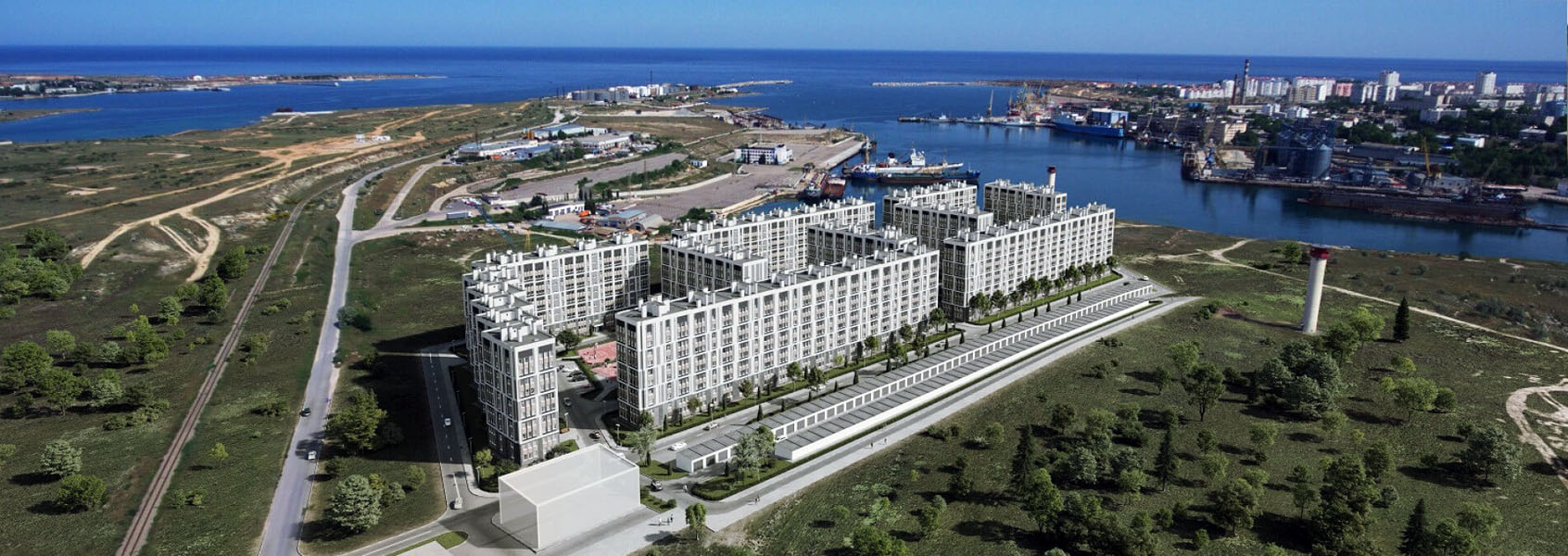
Photo from the Black Sea News archive
Russian statistics agencies, as a rule, publish information on the resident population, i.e. the part of the population that has officially registered the place of residence in Sevastopol and Crimea in the local migration agencies of the Russian Ministry of Internal Affairs, regardless of these people’s actual location.
There is another important indicator for this study – the de facto population, i.e. the total of all persons living in a geographical area, regardless of their place of residence. Under the legislation of the Russian Federation, temporarily present people have to register at the place of temporary residence if they arrive in a locality for longer than 90 days.
There is no official information in open sources about the temporarily present population that has registered its long stay on the territory of the Crimean Peninsula.
Meanwhile, estimates expressed by residents on social media sites, journalists, real estate and housing experts, officials of the occupation administrations, show, for example, that the de facto population of Sevastopol is 700 thousand people, while its resident population is 510 thousand people.
On 28 April 2020, Russian media reported that Acting Russian Governor of occupied Sevastopol Mikhail Razvozhayev told Russian President Putin at a meeting on combating the coronavirus:
“According to the statistics, it was necessary to have hospital bed capacity at the rate of 450 thousand people. I immediately decided to have twice as many, since it is obvious from the consumption of water and bread that more than 700 thousand people live in Sevastopol.”[1]
On 21 December 2020, the Minister of Defence of the Russian Federation, S. Shoygu, while reporting at an extended meeting of the board of the Ministry with the participation of the President of the Russian Federation said:
“The Armed Forces, as well as the country as a whole, have a high incidence of cancer. In 2021, for the benefit of the military personnel and employees of other law enforcement agencies, we propose to begin the construction of a single cancer centre, based at the Burdenko hospital, and a multidisciplinary centre in Sevastopol. We have about 150 thousand security officers and members of their families in this city. Unfortunately, there is no decent medical institution. Vladimir Vladimirovich, I ask you to support the joint initiative of the law enforcement agencies to create these facilities.”[2]
Similarly, experts estimate the size of the de facto population of Simferopol at about 600 thousand people, while its resident population is 362 thousand people.
It is not difficult to solve the riddle if we remember the word “sanctions”: having a stamp of permanent residence registration in occupied Crimea in a Russian internal passport makes it impossible for its holder to obtain visas to the EU, the USA, the UK, and other states that do not recognise the occupation and attempted annexation of Crimea, as well as to have access to other services, such as banking, in the civilised world.
Therefore, it is not surprising that tens of thousands of Russian citizens who live and work in occupied Crimea are in no hurry to change their Moscow or Saratov permanent residence registration to a Crimean address.
First of all, we are talking about thousands and thousands of employees of occupation executive branch agencies and members of their families:
- about 30 local agencies of federal law enforcement, judicial, and military agencies (the Ministry of Internal Affairs, the FSB, the Investigative Committee, the Customs Service, prosecutor’s offices, the Border Service, etc.);
- about 40 local agencies of federal government agencies of the Russian Federation (the Tax Service, the Treasury, the Pension Fund, various types of supervision, etc.);
- 35 executive agencies of Crimean subordination: 19 ministries, 8 state committees, 8 services and inspectorates. They have 445 subordinate enterprises and organisations, including factories, agricultural enterprises, health retreats, nature reserves, etc.
Since the first days and during all the years of the occupation, Russia has been methodically creating its repressive and administrative apparatus in Crimea and Sevastopol by relocating there personnel from Moscow and other regions: law enforcement agencies, supervisory agencies, “supervisors” in the republican and municipal agencies of the occupied territory.
According to estimates based on the analysis of both public and insider information, the proportion of officials relocated from Russia in the departments of Russian federal agencies in Crimea, reporting directly to Moscow, reaches 70%, in the departments reporting to Simferopol – 50%. These figures are constantly increasing.
Crimean leaders of the collaborationist “Crimean government,” government and municipal officials are gradually and systematically being replaced by officials from various regions of Russia, often from depressed regions of the European part of Russia, including the northern ones, and from remote Siberian cities.
Since 2016, the replacement of local personnel by that from Russia has been taking place in areas such as education and health care due to relocation to Crimea of family members of Russian officials and the military, builders of the Crimean bridge and the Tavrida motorway, and military plants engineers.
In 2019, another stage of the staff replacement began: the former head of the Bilorichensky district of Krasnodar Krai of the Russian Federation was appointed head of the occupation administration of the resort capital of the peninsula, the city of Yalta. Understanding the general logic of the processes, we can expect that this was the beginning of the stage of replacing the leadership of the Crimean cities and districts with Russian personnel.
However, back to the migration balance.
Summarising the statistics, calculations, and estimates outlined above, we can conclude that during the years of the occupation, the population of the peninsula, including Sevastopol, has increased by at least 700 thousand – 1 million people due to external migration. This estimate is comprised of the following components (See Table 5).
Table 5. Indicators for estimating the actual number of people who moved to Crimea and Sevastopol
for permanent residence during the occupation period, as of 1 January 2021
|
|
Indicator |
Number of People |
|
|
Moved to the city of Sevastopol for permanent residence (the official statistics as of 01.01.2021) |
180,505 |
|
|
Moved to occupied Crimea for permanent residence (the official statistics as of 01.01.2021) |
201,420 |
|
|
The estimate of how much the actual size of the resident population of Sevastopol exceeds the official one (at a minimum) |
300,000 |
|
|
The estimate of how much the actual size of the resident population of Simferopol exceeds the official one (at a minimum) |
300,000 |
|
|
The estimate of how much the actual size of the resident population of Yalta, Alushta, Yevpatoriia, and Feodosiia exceeds the official one (at a minimum) |
50,000 |
|
|
Total |
1,031,925 |
Thus, as of 1 January 2021, the estimate of the size of the de facto population of the occupied Crimean Peninsula is as follows (See Table 6).
Table 6. The estimate of the size of the de facto population of the occupied Crimean Peninsula, as of 1 January 2021
|
|
Indicator |
Number of People |
|
|
The official size of the resident population of Crimea, excluding Sevastopol (the official statistics as of 01.01.2021) |
1,901,578 |
|
|
The official size of the resident population of Sevastopol (the official statistics as of 01.01.2021) |
509,992 |
|
|
The estimate of how much the actual size of the resident population of Sevastopol, Simferopol, Yalta, Alushta, Yevpatoriia, and Feodosiia exceeds the official one (at a minimum) as of 01.01.2021 |
650,000 |
|
|
The total de facto population of the occupied Crimean Peninsula (the minimum estimate as of 01.01.2021) |
3,061,570 |
Thus, the de facto population of the Crimean Peninsula is at least 3 million people compared with 1,967,200 + 383,304 = 2,350,504 people before the occupation.
Of course, the international sanctions regime and the lack of the Dnieper water supply to the peninsula through the North Crimean Canal act as an effective deterrent – without those, the number of Russian colonisers on the occupied peninsula would be much larger.
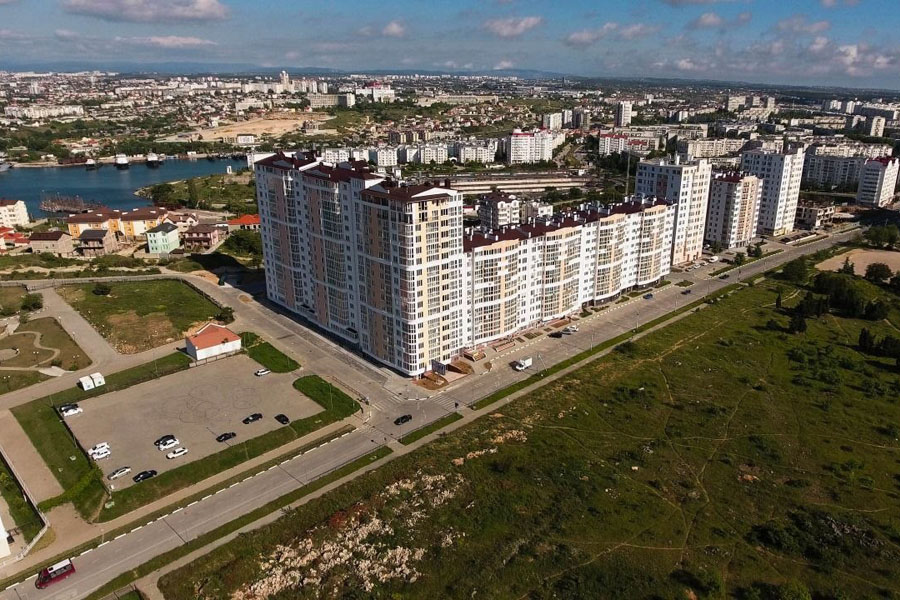
Photo from the Black Sea News archive
[1] https://sevastopol.su/news/razvozhaev-v-sevastopole-realno-zhivet-bolee-700-000-chelovek
[2] http://kremlin.ru/events/president/news/64684
* * *

This article has been published with the support of ZMINA
Human Rights Centre. The content of the article is the sole responsibility of the authors.
More on the topic
- 21.08.2023 Peculiarities of the 2023 Crimean Holiday Season — a «Tourism» in Camouflage
- 06.08.2023 Crimea During the Great War. Part 2. Extreme Tourism or «New Types of Tourism» and Tourist Numbers (2)
- 21.07.2023 Crimean Titan: Under a Russian Holding or a Ukrainian Tank?
- 12.06.2023 Crimea during the Great War. The situation in the occupied Crimea in 2022-2023. Military Context (1)
- 23.11.2021 Occupied Crimea. Exports and Imports / 2014-2021
- 23.11.2021 Water in Occupied Crimea / 2014-2021
- 23.11.2021 The Crimean Budget. Small Business. Salaries and Pensions / 2014-2021
- 23.11.2021 The "Trophy Economy". The Commercial Exploitation of Marine Biological Resources in the Black Sea and the Sea of Azov / 2014–2021
- 21.11.2021 The "Trophy Economy". Militarization as a Factor of Industrial Growth / 2014-2021
- 21.11.2021 Back in the USSR. The Reverse Restructuring of the Crimean Economy / 2014-2021
- 20.11.2021 The "Trophy Economy". The Development of the Stolen Ukrainian Black Sea Shelf / 2014-2021
- 20.11.2021 The Occupied Crimean Tourism / 2014-2021